If people were aware of how simple it is to grow garlic, it would be a much more popular activity! Planting a clove in the fall is all it takes! This pungent bulb enhances the taste of various dishes and is also good for you! It is important to find out which type of garlic will do best in your climate and suit your culinary needs before starting to grow it. Get all the necessary info on cultivating garlic below.
About Garlic
When it comes to stocking our kitchens with essential ingredients, garlic is usually close to the top of the list, along with salt, oil, and pepper. Garlic is a powerful flavor enhancer that can really bring a dish to life.
Garlic has a distinctive taste that is slightly spicy when eaten raw and appears sweeter when cooked. This flavor comes from sulfur compounds. If dried and ground into powder, the pungent taste is removed, and it is an ideal seasoning for meals.
Garlic is a type of lily that is akin to chives, onions, and shallots. It sprouts in the soil as a bulb, which contains edible and curative cloves. Before being used for cooking, the cloves must have their thin, papery covering taken off.
2 Types of Garlic
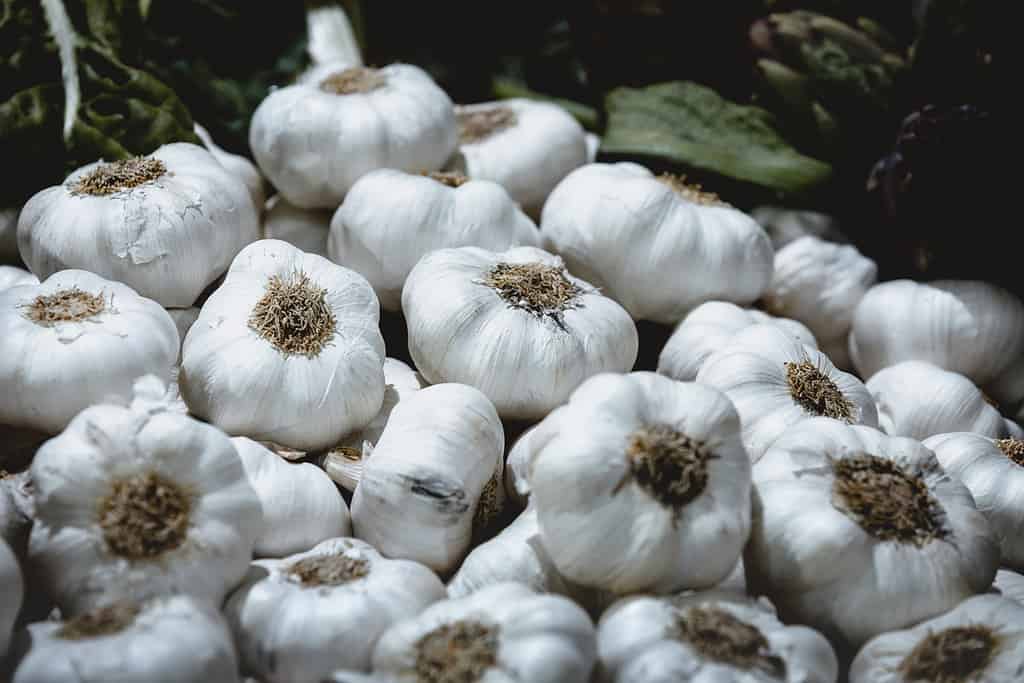
Softneck garlic gets its name from its soft stalk and delicate papery skin that easily peels away.
©Carl.Salisbury/Shutterstock.com
Softneck garlic (Allium sativum) is the most common variety of garlic found in grocery stores. It has a subtle, mild flavor and produces many cloves from each head of garlic. Softneck garlic gets its name from its soft stalk and delicate papery skin that easily peels away. Southern gardeners often use softneck garlic for their gardens as it thrives in warm climates with mild winters. It is known for its bold flavor and large bulbs with smaller cloves. Softnecks do not have scapes. However, they can be stored for longer than hardnecks. As the name implies, the necks remain soft after harvesting, making them ideal for braiding together.
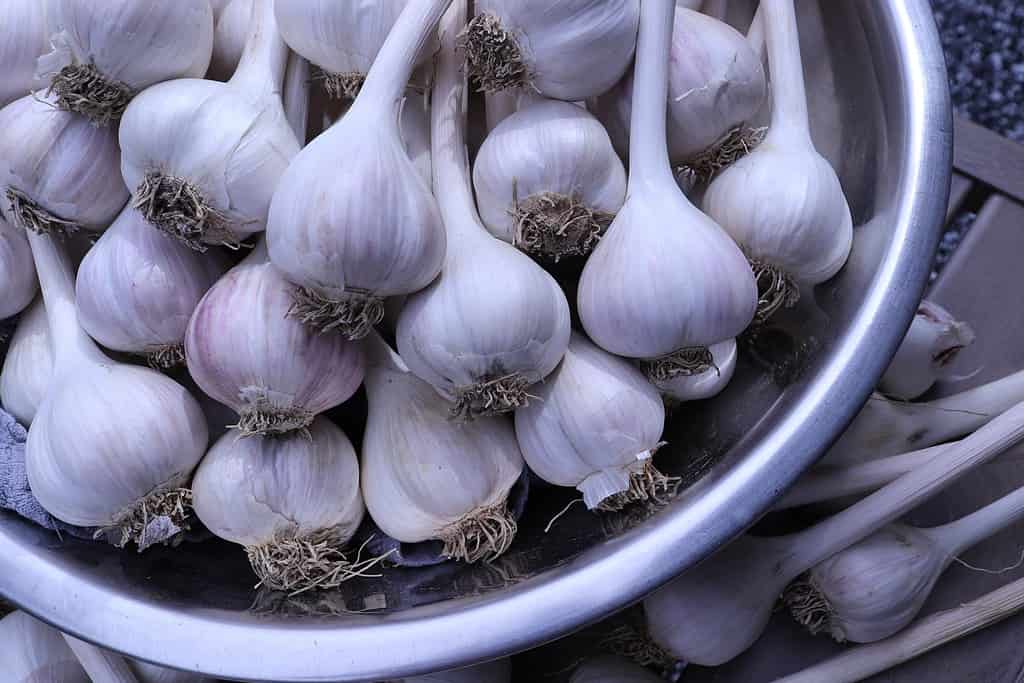
Hardneck varieties are usually only available at farmer’s markets rather than in regular grocery stores.
©KC Melete/Shutterstock.com
Hardneck garlic (Allium ophioscorodon), on the other hand, has a bolder, spicier flavor than softneck varieties. The stalks are woody, and peeling away the skins can be more difficult. Hardneck varieties are usually only available at farmer’s markets rather than in regular grocery stores. Hardneck garlic is a good choice if you want a strong garlic flavor to remain in a cooked dish. Northern gardeners should opt for hardneck garlic since it is exceptionally cold-resistant and can endure severe winters. This variety of garlic possesses a hard stem with one row of big cloves.
Where to Plant
When selecting a planting site for your garlic, ensure it is in an area that receives 6-8 hours of direct sunlight daily. If the soil you plan to plant in is poorly draining or contains too much clay, consider growing your garlic in raised beds instead.
Mix in a generous amount of manure or compost to prepare the soil before planting. Raised beds should be two feet wide and at least 12 inches deep. Mulching with about 6 inches of hay or leaves once the ground has frozen over will help promote better drainage and healthier plants without needing to water them constantly.
When to Plant
When planting garlic, consider your area’s climate and when frost typically occurs. Generally speaking, garlic should be planted in the fall before November. In areas that experience a hard frost, plant garlic cloves six weeks before the first expected fall frost date. This will ensure the ground is not frozen when you try to dig.
In order for garlic to thrive, it needs to go through a period of colder temperatures lasting from 6 to 8 weeks. When garlic bulbs are planted in the autumn, they will have the chance to grow healthy roots before the frost and cold come. Then, when spring comes around, the bulbs are able to start producing foliage and bulbs for you to eat.
In more temperate climates, you can sow garlic cloves as late as early spring, although the bulbs will not be as big. You can still relish the delicious garlic shoots during the summertime. These shoots, called scapes, have a subtle garlic taste and are extremely versatile. Enjoy them on pizza, eggs, or salads. If you choose to plant your garlic in springtime, make sure to wait until the soil has been adequately prepared and crumbles apart with ease. If the soil holds together when you squeeze it, it is too wet.
How to Plant

When selecting your garlic cloves to plant, ensure they are large and healthy – free from any disease or damage.
©nblx/Shutterstock.com
It is important to ensure the soil you are planting in is well-fertilized for optimal growth. Immediately before planting, work a couple of tablespoons of 5-10-10 fertilizer or seaweed meal into the soil eight inches.
When selecting your garlic cloves to plant, ensure they are large and healthy – free from any disease or damage. The larger the clove you choose, the bigger and healthier bulb you will get when it matures at harvest time. Break apart cloves from their bulb a few days before planting but keep their papery husk intact on each clove.
Once ready for planting, space each clove 4 to 8 inches apart and 2 inches deep in its upright position with the pointy side up. Plant in rows that have six-inch pacing between them. One row ten feet long will produce over five pounds of garlic!
How to Grow
Gardeners in areas where the ground freezes should take extra steps to ensure their garlic plants will be able to overwinter and survive. Applying deep mulch, such as leaves or straw, over the beds is essential for insulation and protection from freezing temperatures. The mulch should be removed once spring arrives, after any threat of frost has passed. It’s important to remember that young garlic sprouts cannot tolerate temperatures below 20°F, so don’tdon’t remove the mulch too soon. As soon as warmer weather begins in the spring, new shoots will start growing back up through the soil again, ready for a productive season!
In order to get your garlic to the desired size, remove any flower shoots that emerge. Doing this will help ensure that the bulb reaches its full size and that the plant doesn’tdoesn’t spend excess energy on flower production.
Garlic is a heavy feeder and needs plenty of nutrients during its growth period. In early spring, feed with a balanced slow-release fertilizer which should be repeated just before bulbs begin to swell as daylight lengthens (usually in May). If you notice yellowing foliage, fertilize again, which could indicate a lack of nutrients or other signs of distress.
Once you have selected a planting site for your garlic, keep the area free of weeds. Garlic needs access to all available nutrients in order to grow well and does not tolerate competition from other plants. To ensure the best growth, water your garlic every few days during the bulbing period, from May to June. If this period happens to be especially dry, increase the watering frequency. As July approaches, begin reducing watering so that the bulbs can harden up and cure in drier soil.
When to Harvest
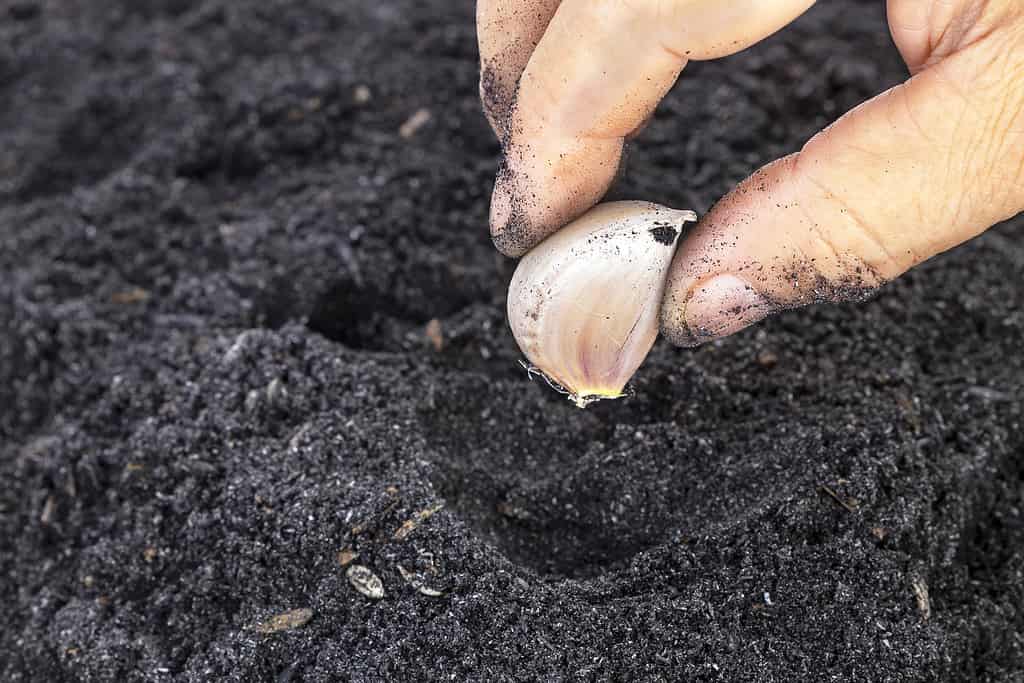
Once ready for planting, space each clove 4 to 8 inches apart and 2 inches deep in its upright position with the pointy side up.
©supersaiyan3/Shutterstock.com
Garlic planted in the fall should be ready to harvest from July to August. If you plant in the spring, you can determine the approximate harvest date by looking at the variety you planted and how many days it takes to reach maturity (usually 90 days). You’ll know it’s time to harvest when the leaves start to turn yellow and droop, but not when they are completely dry.
Prior to collecting all of your garlic, it’s wise to check on one first. Take out a bulb to determine if it is ready to be harvested. The bulb should be divided into firm cloves, and the skin on the outside of the garlic should be dry and papery.
Pulling garlic too early will result in bulbs with a thin outer coating that does not protect them well. They won’twon’t last very long after harvesting.
If the garlic is left in the ground too long, you may notice bulbs that have swollen so large they split open. This exposes the bulbs to disease and other problems that can reduce their longevity while stored away. To ensure your harvested garlic lasts as long as possible, ensure you are harvesting it at just the right time – not too early or too late!
How to Harvest
Once you’ve determined that the bulbs are ready for harvesting, use a garden fork to dig carefully around the stems and roots of each plant. Be sure not to tug or pull at them by hand, as this could damage the roots, especially where they attach to the bulb.
Gently lift up each plant and brush off any excess soil before placing them on a surface in an area with good airflow. This will allow them to dry thoroughly without damaging their delicate foliage or root systems. Once your garlic is completely dry, it can be stored according to your preferences!
How to Store
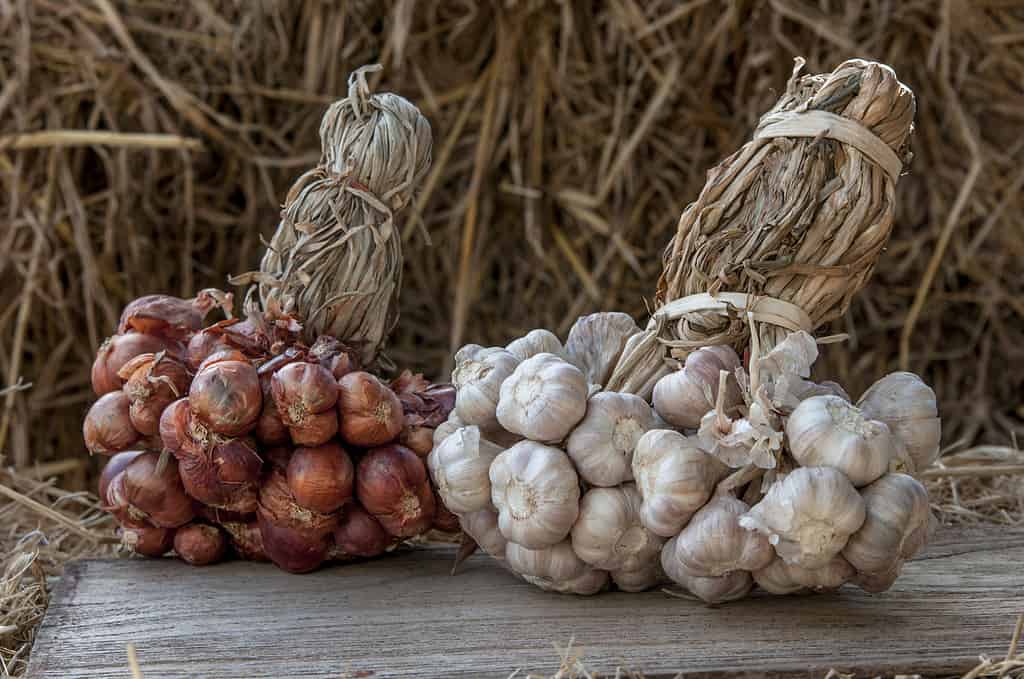
In order to store garlic, start by brushing off the dirt from the bulbs and removing only the most soiled wrappers
©Tongsai/Shutterstock.com
Once the garlic is harvested, it must cure for two weeks in a dry, breezy, and shady spot. The best way to do this is by hanging them on a string in bunches or creating a rack out of wire and wood. This ensures good air circulation from all sides. After about two weeks, the garlic should be completely dried and stored. You can tell when it’s ready as the wrappers will be dried out and rustling in the breeze, and the cloves will crack apart without effort.
In order to store garlic, start by brushing off the dirt from the bulbs and removing only the most soiled wrappers. Trim the garlic roots to ¼ of an inch and cut the stalks to two inches. Bulbs should then be stored in an area that is 55°, dry and dark. A pantry, basement, shed, or empty cupboard works well for this. Refrigerators are not ideal for storing garlic as they are humid and too cold.
With proper storage, garlic can last several months until the next crop is harvested the following year. If you plan on planting your own garlic in the fall, make sure that you save some of your largest and healthiest bulbs for this purpose!
Companion Plants
Garlic can be easily grown and will add flavor to hundreds of different foods. It is also a great addition to any garden since it helps keep away pests and also brings in pollinators.
Garlic can benefit other plants in the garden by providing natural fungicide protection through its soil residue or from the fragrant components of the garlic bulb itself. Additionally, a simple pest deterrent can be created by pureeing one or two garlic cloves in a gallon of water.
Great Companion Plants
Fruit trees. Garlic can be a natural deterrent against pesky bugs that can harm fruit-bearing trees. Many bugs, such as aphids, Japanese beetles, caterpillars, and borers, dislike garlic and will stay away from your garden. Furthermore, garlic can bring in pollinating insects, which are very important for growing fruit.
Tomatoes. Garlic is a great companion plant for tomato plants as it helps to repel pests that can cause damage. Spider mites, in particular, are known to feed on the foliage of tomato plants and can quickly ruin an entire crop if left unchecked. By planting garlic around your tomato plants, you can increase the yield of your tomatoes!
Brassicas. The Brassica family of plants is a great choice to plant in the same bed as garlic. These include cabbage, kale, cauliflower, and broccoli. Growing garlic nearby can help to protect your crops from pests like cabbage worms, cabbage loopers, and Japanese beetles. This makes it a great companion plant for brassicas, which are vulnerable to a wide range of insects.
Tarragon. Tarragon makes a great companion plant for garlic. This licorice-tasting plant helps garlic grow faster!
Roses. Planting garlic around your roses can help to deter aphids from infesting them. Garlic has a strong smell that many insects, like aphids, find offensive and will stay away from plants with garlic planted near them. In addition to helping protect roses from pests, planting garlic near other flowering plants can also be beneficial in keeping the flowers safe and healthy. The smell of the garlic will act as an insect repellent for any nearby blooms, providing natural protection without using any harmful chemicals or treatments.
Bad Companions
Beans. Garlic is not a good plant to have near beans as it inhibits their growth. If you have nitrogen-deficient soil, beans can be a great way to get your soil ready to plant garlic. Beans are nitrogen fixers and will improve the soil. After they are harvested, you can plant garlic in their place now that the soil is full of nitrogen.
Popular Varieties of Garlic
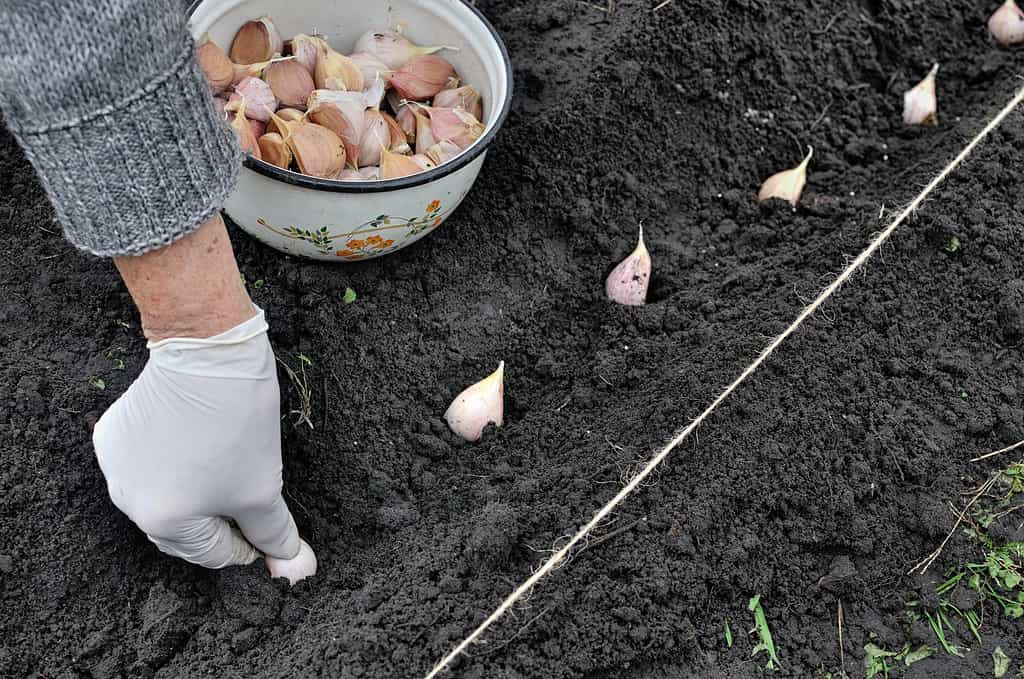
Before planting, you should consider what type of taste you prefer, as each variety has its own unique flavor range, ranging from delicate to zesty.
©yuris/Shutterstock.com
Before selecting the type of garlic to plant, it is important to consider the climate you live in, as it will determine whether a hardneck or softneck variety is best. Additionally, you should consider what type of taste you prefer, as each variety has its own unique flavor range, ranging from delicate to zesty.
Music – This cultivar is a hardneck garlic that is a bit milder than other hardneck garlic. It is not quite as spicy but still holds a strong garlic flavor. A good choice for cooks who love garlic but don’tdon’t love spice.
Chesnok Red – This hardneck garlic is creamy and sweet when roasted and pairs well with large root vegetable roasts.
Inchelium Red – This softneck garlic is popular because of its incredibly long shelf-life. Bulbs easily store away for one year without rotting. It has a mild garlic flavor.
Lorz Italian – This is a popular softneck garlic because it is as spicy and hot as hardneck garlic, but the bulb is as enormous as any softneck garlic can get.
Summary of How to Grow Garlic
| Growing Garlic | Garlic Recommendations |
|---|---|
| Sun | Full Sun. Six or more hours of direct sunlight daily. |
| Soil | Loose, rich, free-draining soil. pH between 6.0 and 7.0 |
| When to Plant | Plant in the fall before the ground is frozen. Usually November. |
| Planting Measurements | Plant bulbs pointy side up two inches deep and 4-8 inches apart. Keep rows six inches apart. |
| When to Harvest | 90 days. Usually July and August. |
| Storage | Cure for 14 days in a dry, breezy spot. Store in a 55°F spot that is dark and dry. |
| Companion Plants | Fruit trees, tomatoes, cabbage, kale, cauliflower, broccoli, tarragon, roses. |
The photo featured at the top of this post is © supersaiyan3/Shutterstock.com
Thank you for reading! Have some feedback for us? Contact the AZ Animals editorial team.






